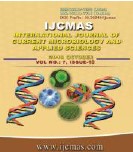


 National Academy of Agricultural Sciences (NAAS)
National Academy of Agricultural Sciences (NAAS)

|
PRINT ISSN : 2319-7692
Online ISSN : 2319-7706 Issues : 12 per year Publisher : Excellent Publishers Email : editorijcmas@gmail.com / submit@ijcmas.com Editor-in-chief: Dr.M.Prakash Index Copernicus ICV 2018: 95.39 NAAS RATING 2020: 5.38 |
Phyllody is a serious disease of sesame caused by phytoplasma. Different types of disease symptoms are reported to be associated with sesame phyllody. The major symptoms are phyllody, Flower virescence, witches broom, shoot tip fasciation, flattening of the shoot apex and cracking of seed capsules. In addition to this, infected plants exhibit reduction of internode distance and of leaf size. Investigations were carried out on the symptomatology of phytoplasma associated with phyllody disease. Twenty genotypes were evaluated for per cent disease incidence, variation with the types of symptoms and disease score in field conditions. Among twenty genotypes two genotypes 17) ES-62 and 5) 12-JUN were found with zero per cent disease incidence resistant to phyllody disease. The disease incidence ranged from 12.5 percent (5-SAVITHRI) to a maximum of 66.66 per cent (26) SI-1687-1). The development of symptoms was also studied from 30 to 60 days after sowing where in none of genotypes produced symptoms at 30DAS, however from 45th day onwards symptoms were observed in all the genotypes except in 3 genotypes, 17) ES-62 and 5) 12-JUN did not produce any symptoms even at 60DAS. 11 Genotypes showed only phyllody symptoms, 2 genotypes produced witches broom symptom, while 2 genotypes showed phyllody as well as twisting of stem. Cracking of capsule was observed in genotype 24) JLT-408, while vivipary and phyllody symptom was observed in genotype 17) RT-351. Among 20 genotypes 17) ES-62 and 5) 12-JUN ranked as highly resistant and 4 genotypes ranked as moderately resistant.
 |
 |
 |
 |
 |